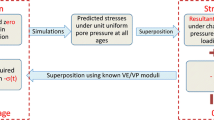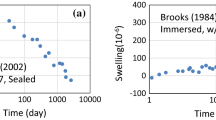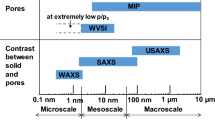Abstract
There are several conflicting opinions in the literature concerning the significance and role of bulk pore liquid pressure and disjoining pressure on the desiccation shrinkage of cementitious materials. While the applicability of the Kelvin–Laplace equation in fine pores (due to the unstable nanosized meniscus) has been questioned by some, disjoining pressure has been advocated to be the primary mechanism driving desiccation shrinkage in cementitious materials. In order to elucidate the proper contribution and understanding of these two mechanisms, a thermodynamics-based mechanistic approach has been utilized here to derive expressions for both the bulk liquid pressure and the disjoining pressure. The validity of the poromechanical approach to modeling shrinkage of a porous body has also been examined. It has been concluded that the determination of pore liquid pressure via the Kelvin–Laplace equation does not require the presence of a stable meniscus and is applicable to nanosized pores. As such, the pore liquid pressure is found to be the primary mechanism associated with the desiccation shrinkage of cementitious materials. While disjoining pressure does not induce any change in the bulk liquid stress during drying, it plays a significant role in counterbalancing the liquid pressure in the thin film separating the vapor phase from the pore wall, which justifies poromechanical shrinkage models that consider pressurization to occur only in the portion of the pores containing bulk pore liquid.




Similar content being viewed by others
Notes
In fact, the English word capillary derives from the Latin root capillus, which translates directly as hair.
As pointed out by Rajagopal [28], “pressure” is vaguely introduced in most texts without any proper attention or description of what it means. Common usage of the term pressure is typically applied to simple, linear fluids and gases that have a spherical stress state such that the each normal stress component of the stress tensor is equal in magnitude to the mean normal stress. In such cases, one might get away with ambiguity; not so here where the stress tensor of thin liquid films is proposed by Derjaguin to be nonspherical.
Note that the relative humidity cannot be zero because at zero relative humidity the vapor and liquid cannot coexist. Also, a zero relative humidity blows the mathematical formulation.
Unless the pore sizes change due to the precipitation of hydration products/dissolved ions, or dissolution of pore wall due to some chemical reaction, the contraction/expansion of the pore network due to shrinkage or swelling may cause negligible change in the pore dimensions.
Surface tension is acting along the θ direction and therefore does not have any component in the radial direction.
References
Coussy, O.: Mechanics and Physics of Porous Solids. Wiley, West Sussex (2010)
Baroghel-Bouny, V., et al.: Characterization and identification of equilibrium and transfer moisture properties for ordinary and high-performance cementitious materials. Cem. Concrete Res. 29(8), 1225–1238 (1999)
Coussy, O., et al.: The equivalent pore pressure and the swelling and shrinkage of cement-based materials. Mater. Struct. 37(1), 15–20 (2004)
Grasley, Z.C., Leung, C.K.: Desiccation shrinkage of cementitious materials as an aging, poroviscoelastic response. Cem. Concrete Res. 41(1), 77–89 (2011)
Beltzung, F., Wittmann, F.H.: Role of disjoining pressure in cement based materials. Cem. Concrete Res. 35(12), 2364–2370 (2005)
Ferraris, C.F., Wittmann, F.H.: Shrinkage mechanisms of hardened cement paste. Cem. Concrete Res. 17(3), 453–464 (1987)
Young, T.: An essay on the cohesion of fluids. Philos. Trans. R. Soc. Lond. 95, 65–87 (1805)
Laplace, P.S. (English translation by N. I. Bowditch).: Supplement to the Theory of Capillary Attraction. In: Celestial Mechanics, vol. 4 (1829)
Thomson, W.: On the equilibrium of vapour at a curved surface of liquid. Philos. Mag. 4(42), 448–452 (1871)
von Helmholtz, R.: Investigations of vapors and mists, especially of such things from solutions. Ann. Phys. 263(4), 508–543 (1886)
Coussy, O.: Deformation and stress from in-pore drying-induced crystallization of salt. J. Mech. Phys. Solids 54(8), 1517–1547 (2006)
Grasley, Z., Rajagopal, K.: Revisiting total, matric, and osmotic suction in partially saturated geomaterials. Z. Angew. Math. Phys. 63(2), 373–394 (2012)
Wittmann, F.H.: Heresies on shrinkage and creep mechanisms. In: Tanabe, T-A., Sakata, K., Mihashi, H., Sato, R., Maekawa, K., Nakamura, H. (eds.) Creep, Shrinkage and Durability Mechanics of Concrete and Concrete Structures. Taylor and Francis Group, Ise-Shima (2009)
Wittmann, F.: Useful fundamentals of shrinkage and creep of concrete. In: CONCREEP 10, pp. 84–93. American Society of Civil Engineers (2015)
Fisher, L.R., Israelachvili, J.N.: Direct measurement of the effect of meniscus forces on adhesion: a study of the applicability of macroscopic thermodynamics to microscopic liquid interfaces. Colloids Surf. 3(4), 303–319 (1981)
Fisher, L.R., Israelachvili, J.N.: Experimental studies on the applicability of the Kelvin equation to highly curved concave menisci. J. Colloid Interface Sci. 80(2), 528–541 (1981)
Fisher, L.R., Gamble, R.A., Middlehurst, J.: The Kelvin equation and the capillary condensation of water. Nature 290(5807), 575–576 (1981)
Christenson, H.K.: Capillary condensation in systems of immiscible liquids. J. Colloid Interface Sci. 104(1), 234–249 (1985)
Christenson, H.K.: Adhesion between surfaces in undersaturated vapors—a reexamination of the influence of meniscus curvature and surface forces. J. Colloid Interface Sci. 121(1), 170–178 (1988)
Digilov, R.: Kelvin equation for meniscuses of nanosize dimensions. Langmuir 16(3), 1424–1427 (2000)
Grasley, Z.C., Rajagopal, K.R., Leung, C.K.: Equilibrium of partially dried porous media influenced by dissolved species and the development of new interfaces. Int. J. Eng. Sci. 49(7), 711–725 (2011)
Lewis, G.N.: The law of physico-chemical change. Proc. Am. Acad. Arts Sci. 37(3), 49–69 (1901)
Churaev, N.V.: Derjaguin’s disjoining pressure in the colloid science and surface phenomena. Adv. Coll. Interface. Sci. 104(1–3), 15–20 (2003)
Derjaguin, B.: Untersuchungen über die Reibung und Adhäsion. IV. Kolloid-Zeitschrift 69(2), 155–164 (1934)
Derjaguin, B.V.: Disjoining pressure. In: Derjaguin, N.V.C.B.V., Muller, V.M. (eds.) Surface forces. Springer, New York (1987)
Derjaguin, B.V., Churaev, N.V., Muller, V.M.: Surface forces. Consultants Bureau, New York (1987)
Meixner, J., de Groot, S.R., Mazur, P.: Non-Equilibrium Thermodynamics. North-Holland Publishing Company, Amsterdam (1962). X und 510 Seiten, Preis: Gebunden DM 49,50. Zeitschrift für Elektrochemie, Berichte der Bunsengesellschaft für physikalische Chemie 66(10): 883–884 (1962)
Rajagopal, K.R.: Remarks on the notion of “pressure”. Int. J. Non-Linear Mech. 71, 165–172 (2015)
Landau, L.D., et al., Electrodynamics of Continuous Media. Pergamon Press, Oxford (1984)
Scherer, G.W.: Personal communication (2016)
Israelachvili, J.N.: Chapter 14—Electrostatic forces between surfaces in liquids. In: Intermolecular and Surface Forces, third edn, pp. 291–340. Academic Press, San Diego (2011)
Grasley, Z.C., Rajagopal, K.R.: Revisiting total, matric, and osmotic suction in partially saturated geomaterials. Z. Angew. Math. Phys. 63(2), 373–394 (2011)
Wittmann, F., Splittgerber, H., Ebert, K.: A study of the van der Waals force at small distances. Zeitschrift für Physik 245(4), 354–360 (1971)
Wittmann, F.H.: Grundlagen eines modells zur beschreibung charakteristischer eigenschaften des betons. Ernst (1977)
Splittgerber, H.: Spaltdruck zwischen festkorpern und auswirkungen auf probleme in der technik. Cem. Concrete Res. 6(1), 29–35 (1976)
Biot, M.A.: General theory of three-dimensional consolidation. J. Appl. Phys. 12(2), 155–164 (1941)
Biot, M.A.: Theory of propagation of elastic waves in a fluid-saturated porous solid. I. Low-frequency range. J. Acoust. Soc. Am. 28(2), 168–178 (1956)
Coussy, O., Monteiro, P.J.M.: Poroelastic model for concrete exposed to freezing temperatures. Cem. Concrete Res. 38(1), 40–48 (2008)
Coussy, O.: Poromechanics. Wiley, West Sussex (2004)
Coussy, O.: Poromechanics of freezing materials. J. Mech. Phys. Solids 53(8), 1689–1718 (2005)
Yan, P., et al.: Relationship between delayed ettringite formation and delayed expansion in massive shrinkage-compensating concrete. Cement Concr. Compos. 26(6), 687–693 (2004)
Atiş, C.D.: High-volume fly ash concrete with high strength and low drying shrinkage. J. Mater. Civ. Eng. 15(2), 153–156 (2003)
Chindaprasirt, P., Homwuttiwong, S., Sirivivatnanon, V.: Influence of fly ash fineness on strength, drying shrinkage and sulfate resistance of blended cement mortar. Cem. Concrete Res. 34(7), 1087–1092 (2004)
Acknowledgements
This research was partially supported by the National Science Foundation under Grant No. 1463926. Any opinions, findings, and conclusions or recommendations expressed in this material are those of the author(s) and do not necessarily reflect the views of the National Science Foundation. The authors would like to thank G.W. Scherer for helpful discussion.
Author information
Authors and Affiliations
Corresponding author
Rights and permissions
About this article
Cite this article
Rahman, S.F., Grasley, Z.C. The significance of pore liquid pressure and disjoining pressure on the desiccation shrinkage of cementitious materials. Int J Adv Eng Sci Appl Math 9, 87–96 (2017). https://doi.org/10.1007/s12572-017-0186-5
Published:
Issue Date:
DOI: https://doi.org/10.1007/s12572-017-0186-5




